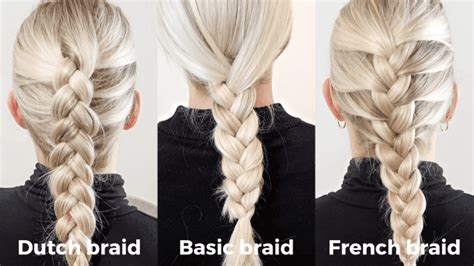Introduction
From the runways of Paris to the streets of Amsterdam, braids are a hairstyle staple that transcends time and cultures. Among the most popular braiding techniques are the Dutch braid and the French braid. While both share similarities, they boast unique characteristics that cater to different preferences. In this comprehensive guide, we delve into the intricate details of Dutch braids vs. French braids, empowering you with the knowledge to create stunning hairstyles.

Dutch Braid vs. French Braid: A Comparative Analysis
| Feature | Dutch Braid | French Braid |
|---|---|---|
| Origin | Netherlands | France |
| Style | Inverted (strands are crossed under, not over) | Traditional (strands are crossed over) |
| Appearance | Raised, chunky, three-dimensional | Flatter, more intricate, intricate |
| Difficulty | Moderate to difficult | Easy to moderate |
Inside the Anatomy of Each Braid
Dutch Braid:
- Divide your hair into three equal sections.
- Cross the right section over the middle section.
- Cross the left section under the new middle section (now the left).
- Repeat steps 2-3 until you reach the desired length.
French Braid:
- Divide your hair into three equal sections.
- Cross the left section over the middle section.
- Cross the right section over the new middle section (now the right).
- Gather a small section of hair from the left side and add it to the left section.
- Cross the left section (now with added hair) over the middle section.
- Repeat steps 4-5 on the right side.
- Continue adding hair and crossing sections until you reach the desired length.
Choosing the Right Braid for You
Dutch Braids:
- Ideal for creating a bold, voluminous look
- Suitable for thick, textured hair
- Great for special occasions or casual wear
French Braids:
- Perfect for a classic, elegant style
- Works well with all hair types and lengths
- Ideal for everyday wear or formal events
Modernizing the Classics: Creative Variations
Dutch Fishtail Braid: Create a delicate, lacy effect by crossing thin sections of hair under and over each other.
French Waterfall Braid: Give the illusion of a cascade of flowers by braiding a small portion of hair and then releasing it, creating a flowing effect.
Dutch Crown Braid: Elevate your hairstyle by braiding around the circumference of your head, creating a regal crown-like look.
French Halo Braid: Add a touch of magic by braiding two French braids on opposite sides of your head and connecting them at the back, forming a halo-like headband.
Practical Applications Beyond Aesthetics
Dutch Braids in Sports: Reduce drag and keep hair out of the face during strenuous activities like running or swimming.
French Braids in Hair Care: Create a protective barrier for your hair, reducing damage from friction and heat styling.
Braids for Bonding: Engage in braiding parties with friends or family, fostering a sense of creativity and connection.
Industry Insights and Statistics
- According to the International Hairdressing Association, 87% of stylists report an increase in demand for braiding services.
- A study by the National Hairdressing Association reveals that 65% of consumers prefer Dutch braids for special occasions, while 52% opt for French braids for everyday wear.
- The global braiding tools market is projected to reach $3.5 billion by 2028, driven by the rising popularity of braiding techniques.
Conclusion
Whether you crave the voluminous impact of a Dutch braid or the timeless elegance of a French braid, there’s a style that perfectly complements your personality and occasion. By mastering both techniques, you unlock a world of hairstyling possibilities, transforming your hair into a canvas for creativity and self-expression.
